Knossos, Crete is the largest Bronze Age archaeological site on Crete, probably the ceremonial and political centre of the Minoancivilization and culture.
It has been substantially and imaginatively "rebuilt", making the site accessible to the casual visitor in a way that a field of unmarked ruins is not.
The Palace of Knossos is the largest and most spectacular of all theMinoan palatial centres, covering an area of 20,000 sqm. The palace had many storeys, it was built of ashlars blocks and its walls were decorated with splendid frescoes, mostly representing religious ceremonies.

Knossos Video
The ruins at Knossos were discovered in 1878 by Minos Kalokairinos, a Cretan merchant and antiquarian. He conducted the first excavations, which brought to light part of the storage magazines in the west wing and a section of the west facade.
After Kalokairinos, several people attempted to continue the excavations, but it was not until March 16, 1900 that archaeologistArthur Evans, an English gentleman of independent means, was able to purchase the entire site and conduct massive excavations.
The excavation and restoration of Knossos, and the discovery of the culture he labeled Minoan, is inseparable from the individualEvans. Nowadays archeology is a field of academic teamwork and scientific rigor, but a century ago a project could be driven by one wealthy and self-taught person. Assisted by Dr. Duncan Mackenzie, who had already distinguished himself by his excavations on the island of Milos, and Mr. Fyfe, the British Schoolat Athens architect, Evans employed a large staff of local laborers as excavators and within a few months had uncovered a substantial portion of what he named the Palace of Minos.










The term palace may be misleading: in modern English, it usually refers to an elegant building used to house a head of state or similar.
Knossos was a complex collection of over 1000 interlocking rooms, some of which served as artisans' workrooms and food processing centres (e.g. wine presses). It served as a central storage point, and a religious and administrative centre.
The site has had a very long history of human habitation, beginning with the founding of the first Neolithic settlement circa 7000 BCE.


The palace is about 130 meters on a side and since the Roman period has been suggested as the source of the myth of theLabyrinth, an elaborate maze-like structure constructed for King Minos of Crete and designed by the legendary artificer Daedalus to hold the Minotaur, a creature that was half man and half bull and was eventually killed by the Athenian hero Theseus.

Labyrinth comes from the word labrys, referring to a double, ortwo-bladed axe. Its representation had a religious and probablymagical significance. It was used throughout the Mycenaeanworld as an apotropaic symbol; that is, the presence of the symbol on an object would prevent it from being "killed."
Axe motifs were scratched on many of the stones of the palace. It appears in pottery decoration and is a theme of the Shrine of the Double Axes at the palace, as well as of many shrines throughout Crete and the Aegean.
The etymology of the name is not known; it is probably not Greek. The form labyr-inthos uses a suffix generally considered to be pre-Greek.
The location of the labyrinth of legend has long been a question forMinoan studies. It might have been the name of the palace or of some portion of the palace.
Throughout most of the 20th century the intimations of human sacrifice in the myth puzzled Bronze Age scholarship, because evidence for human sacrifice on Crete had never been discovered and so it was vigorously denied. The practice was finally verified archaeologically (see under Minoan civilization). It is possible that the palace was a great sacrificial centre and could have been named the Labyrinth. Its layout certainly is labyrinthine, in the sense of intricate and confusing. Many other possibilities have been suggested. The modern meaning of labyrinth as a twisting maze is based on the myth.







The great palace was built gradually between 1700 and 1400 BC, with periodic rebuilding after destruction. Structures preceded it onKephala hill.
The features that are currently most visible date mainly to the last period of habitation which Evans termed Late Minoan. The palace has an interesting layout - the original plan can no longer be seen because of the subsequent modifications.
Also, there are not several main hallways. Instead, 1300 rooms are connected with corridors of varying sizes and direction. The six acres of the palace included a theatre, a main entrance on each of its four cardinal faces, and extensive storerooms (also called magazines).
The storerooms contained pithoi (large clay vases) that held oil, grains, dried fish, beans, and olives. Many of the items were created at the palace itself, which had grain mills, oil presses, andwine presses. Beneath the pithoi were stone holes used to store more valuable objects, such as gold.
The palace used advanced architectural techniques; for example, part of it was built up to five storeys high. The palace had at least three separate liquid management systems, one for supply, one for drainage of runoff, and one for drainage of waste water.

Aqueducts brought fresh water to Kephala hill from springs atArchanes, about 10 km away. Springs there are the source of theKairatos River, in the valley of which Kephala is located.
The aqueduct branched to the palace and to the town. Water was distributed at the palace by gravity feed through terra cotta pipesto fountains and spigots. The pipes were tapered at one end to make a pressure fit, with rope for sealing. The water supply system would have been manifestly easy to attack. No hidden springs have been discovered as at Mycenae.
Sanitation drainage was through a closed system leading to asewer apart from the hill. The Queen's Megaron contained an example of a flush toilet adjoining the bathroom. This toilet was a seat over drain flushed by pouring water from a jug.
The bathtub located in the adjoining bathroom similarly had to be filled by someone heating, carrying, and pouring water, and must have been drained by overturning into a floor drain or by bailing. This toilet and bathtub were exceptional structures within the 1300-room complex.
As the hill was periodically drenched by torrential rains, a runoff system was a necessity. It began with channels in the flat surfaces, which were zig-zag and contained catchment basins to control the water velocity. Probably the upper system was open. Manholesprovided access to parts that were covered.
Due to its placement on the hill, the palace received sea breezesduring the summer. It had porticoes and airshafts.
The palace was designed to take best advantage of natural lighting during the long days of the summer season. The suites of rooms were arranged around courtyards to provide more window openings, the doors were polythyra ("multiple-door") to provide more door opening area, stairs wound around the periphery of light wells, and corridors were open porticos wherever possible.
One cannot imagine that the palace shut down at night for lack of light, however. Minoan Crete had a long tradition of ceramic lamps, which consisted of a reservoir of olive oil surrounded by niches for one or more wicks. The better lamps multiplied the niches andwicks to provide more candle-power.

Winter must have presented the Palace of Minos with as much of aheating problem as its architecture solved the lighting problem. The wind would have swept through the open palace, increasing the chill factor, unless the openings were blocked. The door openingsmust have been provided with doors of wood or bronze, as in laterClassical times.
The Town Mosaic, a depiction of houses on faience found atKnossos, shows windows with cross-members and four panes, suggesting that some translucent substance was used to block the openings. There is no sign of glass panes. No central heating is in evidence. The rooms must have been heated individually.
Fixed hearths were used to some degree but there is long tradition of portable ceramic hearths as well. The Minoans never made the transition from a portable hearth to a closed metal stove, which would have been technologically within their grasp and are much more efficient radiators.
Fires within the palace were for the most part of charcoal, probably lit with olive oil, in hearths or braziers. The tall drafty rooms, probably with smoke openings at the top (the roofs did not survive), were designed to keep the smoke away from the humans and evacuate it as quickly as possible. The palace undoubtedly reeked of smoke within and gave a pillar of it without. The odour problem would have been solved with incense and perfumed unguents kept in pyxes, as far as it could be.

The emphasis of palace civilizations in colder climates on home production of textiles is understandable. The open vests of the women and the loin cloths of the nearly nude men could only have been summer attire.
No frescos of snow-clad mountains and frosty plains are in evidence, such as appear in Crete in the winter. Over such a length of time, no perishables, such as boots or winter robes, have survived, but the frescos cannot depict year-round ordinary life in Crete.

They were also 'inverted' - most Greek columns are smaller at the top and wider at the bottom to create the illusion of greater height, but the Minoan columns are smaller at the bottom and wider at the top. The columns at the Palace of Minos were mounted onstone bases and had round, pillow-like capitals (i.e. tops).
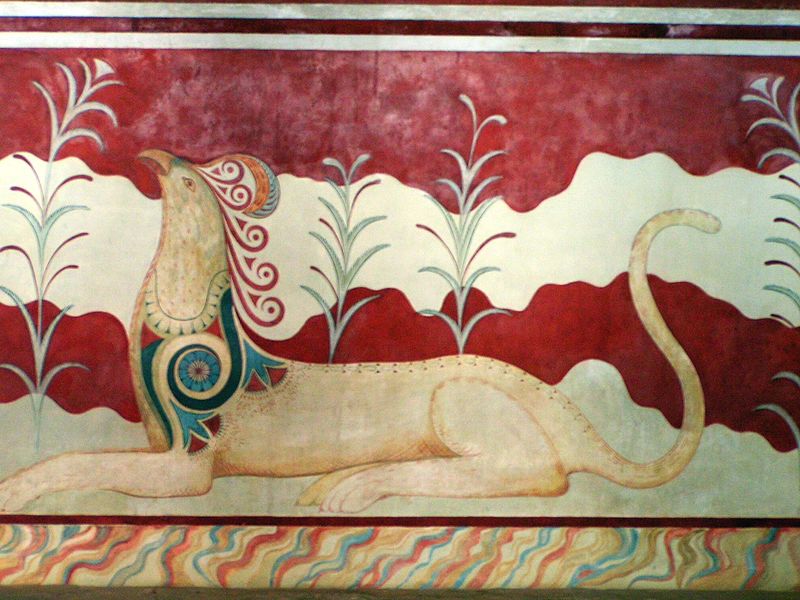
These sophisticated, colourful paintings portray a society which, in comparison to the roughly contemporaneous art of Middle and New Kingdom Egypt, was either conspicuously non-militaristic or did not choose to portray military themes anywhere in their art. (See Minoan civilisation.)
One remarkable feature of their art is the colour-coding of the sexes: the men are depicted with ruddy skin, the women as milky white. Almost all their pictures are of young or ageless adults, withfew children or elders depicted.
In addition to scenes of men and women linked to activities such asfishing and flower gathering, the murals also portray athletic feats.
The most notable of these is bull-leaping, in which an athlete grasps the bull's horns and vaults over the animal's back. The question remains as to whether this activity was a religious ritual, possibly a sacrificial activity, or a sport, perhaps a form of bullfighting.
Many people have questioned if this activity is even possible; the fresco might represent a mythological dance with the Great Bull. The most famous example is the Toreador Fresco, painted around 1550-1450 BCE, in which a young man, flanked by two women, apparently leaps onto and over a charging bull's back. It is now located in the Archaeological Museum of Heraklion in Crete.

The centerpiece of the "Mycenaean" palace was the so-calledThrone Room or Little Throne Room, dated to LM II. This chamber has an alabaster seat identified by Evans as a "throne" built into the north wall.
On three sides of the room are gypsum benches. A sort of tub areais opposite the throne, behind the benches, termed a lustral basin, meaning that Evans and his team saw it as a place for ceremonial purification.
The room was accessed from an anteroom through two double doors. The anteroom in turn connected to the central court, which was four broad steps up through four doors. The anteroom had gypsum benches also, with carbonized remains between two of them thought to be a possible wooden throne. Both rooms are located in the ceremonial complex on the west of the central court.
The throne is flanked by the Griffin Fresco, with two griffins couchant (lying down) facing the throne, one on either side. Griffins were important mythological creatures, also appearing on seal rings, which were used to stamp the identity of the bearer into pliable material, such as clay or wax. The actual use of the room and the throne is unclear. The two main theories are:
The seat of a priest-king or his consort, the queen. This is the older theory, originating with Evans. In that regard Matz speaks of the "heraldic arrangement" of the griffins, meaning that they are more formal and monumental than previous Minoan decorative styles. In this theory, the Mycenaean Greeks would have held court in this room, as they came to power in Knossos at about 1450. The "lustral basin" and the location of the room in a sanctuary complex cannot be ignored; hence, "priest-king."
A room reserved for the epiphany of a goddess, who would have sat in the throne, either in effigy, or in the person of apriestess, or in imagination only. In that case the griffins would have been purely a symbol of divinity rather than a heraldic motif.

The lustral basin was originally thought to have had a ritual washing use, but the lack of drainage has more recently brought some scholars to doubt this theory.
A long-standing debate between archaeologists concerns the main function of the palace, whether it acted primarily as an administrative centre, a religious centre - or both, in a theocratic manner.
Other important debates consider the role of Knossos in the administration of Bronze Age Crete, and whether Knossos acted as the primary centre, or was on equal footing with the several other contemporary palaces that have been discovered on Crete.
Many of these palaces were destroyed and abandoned in the early part of the 15th century BCE, possibly by the Mycenaeans, although Knossos remained in use until destroyed by fire about 100 hundred years later.
It is worth noting that Knossos showed no signs of being a military site -- no fortifications or stores of weapons, for example. Minoan civilization was a remarkably un-militaristic society. Likewise, the position of Minoan women was unusual compared to any other contemporary society.




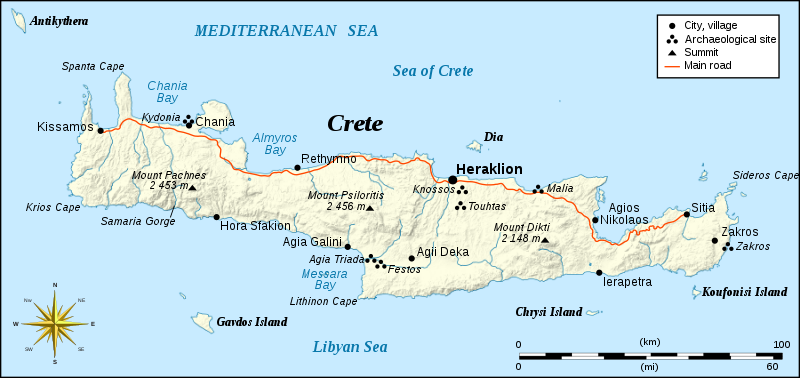
View Larger Map


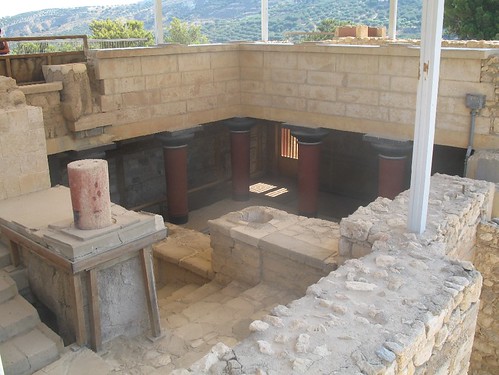

In frond of the Queen’s throne – the frescoe with the dolphins

The room with the shield having the shape of the number 8
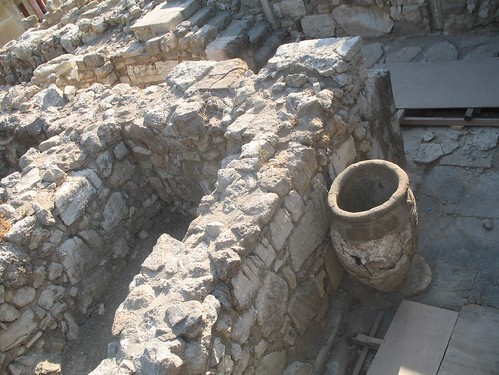

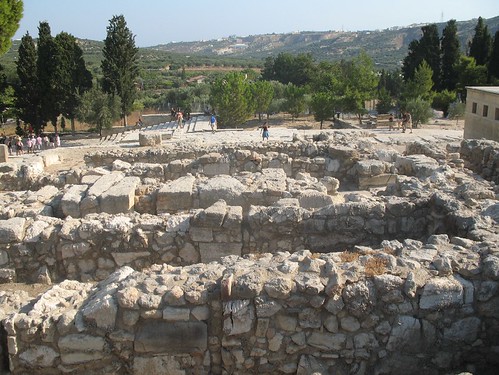
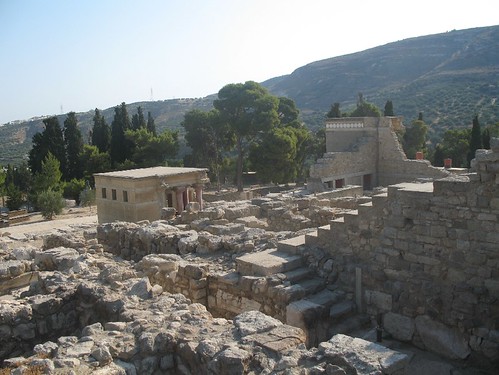
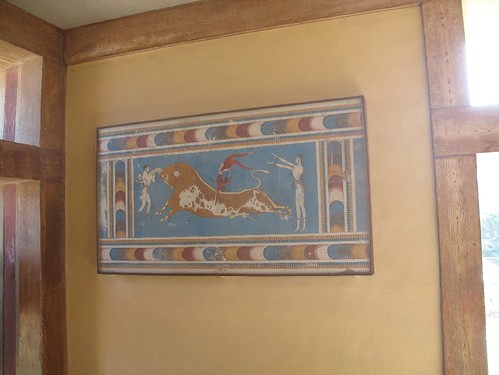
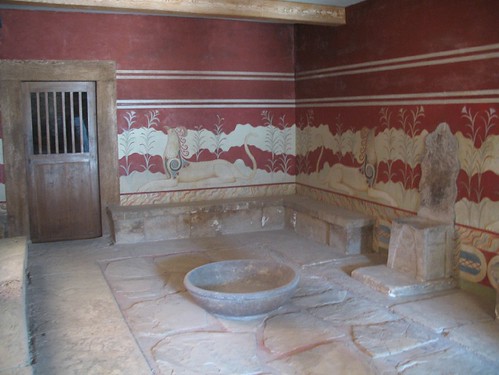
http://candia.wordpress.com/photos/photos-from-knossos/
http://www.crete.tournet.gr/index.php




In frond of the Queen’s throne – the frescoe with the dolphins

The room with the shield having the shape of the number 8






http://candia.wordpress.com/photos/photos-from-knossos/
http://www.crete.tournet.gr/index.php
Herakleion Archaeological Museum
The Herakleion Archaeological Museum is one of the largest and most important museums in Greece, and among the most important museums in Europe. It houses representative artefacts from all the periods of Cretan prehistory and history, covering a chronological span of over 5,500 years from the Neolithic period to Roman times. The singularly important Minoan collection contains unique examples of Minoan art, many of them true masterpieces. The Herakleion Museum is rightly considered as the museum of Minoan culture par excellence worldwide.
The museum, located in the town centre, was built between 1937 and 1940 by architect Patroklos Karantinos on a site previously occupied by the Roman Catholic monastery of Saint-Francis which was destroyed by earthquake in 1856. The museum’s antiseismic building is an important example of modernist architecture and was awarded a Bauhaus commendation. Karantinos applied the principles of modern architecture to the specific needs of a museum by providing good lighting from the skylights above and along the top of the walls, and facilitating the easy flow of large groups of people. He also anticipated future extensions to the museum. The colours and construction materials, such as the veined polychrome marbles, recall certain Minoan wall-paintings which imitate marble revetment. The two-storeyed building has large exhibition spaces, laboratories, a drawing room, a library, offices and a special department, the so-called Scientific Collection, where numerous finds are stored and studied.
Here below you can follow a video as broadcasted by the natinal channel NET at “We stay in Greece” daily show.



Δεν υπάρχουν σχόλια:
Δημοσίευση σχολίου